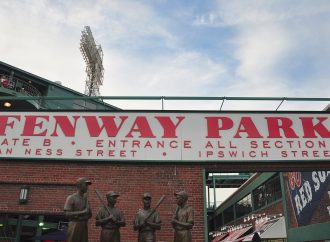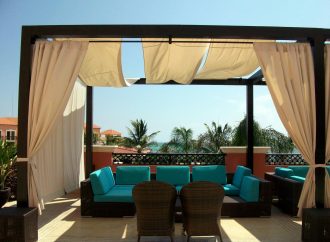The current Madison Square Garden above Penn Station is the fourth entertainment arena with that name in New York City. The Garden’s roots trace back to the northeast corner of Madison Square, where the first two Madison Square Gardens stood, starting with the first, built in 1879.
Before the current day Madison Square Garden, which was completed in 1968, there was actually three Madison Square Garden’s that were open to attract the people of New York and around the world to enjoy various sports, concerts and other forms of entertainment. The original Madison Square Garden was originally constructed and was open for business starting in 1871 in Manhattan. In 1890 the second Madison Square Garden opened on the same site as the original. Once again, Madison Square Garden was not open for long when a new Garden was built, now the third different Madison Square Garden within 60 years, opening in 1925. Lastly, the current day Madison Square Garden opened in 1968. All of the Madison Square Garden’s had a big impact on the culture of New York City, even though that they were not all on the same site.
Madison Square Garden opened its door to the public in 1879. Being located in the heart of New York City was one thing, but its entertainment prowess was another. It was named “Coolest Arena” by Rolling Stones and “Venue of the Decade” by Billboard in the United States. Filled with creation and destruction, the history of Madison Square Garden is alive even to this day and recalled by many. There were three versions built in 1890, 1925, and the current version built-in 1968. Let us talk more about how it came to existence and became one of the most iconic arenas of its time.
The First Version (1879-1890)
The first version of Madison Square Garden was operated by P.T. Barnum. It was used for events such as the Westminster Dog Show and circuses. Then, Cornelius Vanderbilt, who was a rail tycoon, shifted his railroad’s main station to Grand Terminal. Even though Mr. Barnum had operated Madison Square Garden for many years, the Vanderbilt family had reclaimed the land and reopened Madison Square Garden in 1879. The arena quickly became the center of attention and turned into a venue for cycling races, boxing matches, and presidential rallies.
The Second Version (1890-1925)
In 1889, Madison Square Garden was sold to Andrew Carnegie and J.P. Morgan. Mr. Carnegie was an industrialist by profession, whereas Mr. Morgan was an influential banking individual. Within a year, Madison Square Garden was destined to receive a major makeover, which was termed as ‘dramatic’ by many. The old arena remained open to the public. However, it became quite uncomfortable as it became hot during the summers and freezing cold in winter. The new garden was designed by architect Stanford White in an enclosed Beaux Arts Style.
Additionally, MSG went onto become the second tallest structure in NYC upon its completion due to the installation of a bell tower inspired by the bell tower of Seville. The Football World Series that took place in 1902 and 1903 were held in MSG at the time when the American game was still going through its birth stages.
The Tragedy
There was no denying that MSG’s charm was way ahead of its time. However, one tragedy awaiting would change the course of history for MSG. Even though architect Stanford White possessed a friendly person but he was a seducer of young women as well. Model and chorus girl, Elizabeth Nesbit was one of the catches who unsurprisingly became affectionate towards Mr. White while he was 42 and she was 16. As the relationship moved on its course, Nesbit was assaulted while unconscious in Mr. White’s 24th street apartment.
Nesbit would go on to marry Harry Kendall Thaw, heir to a coal fortune but a mentally unstable one. Harry, on learning about Nesbit’s past, became jealous, and it pushed him to the point where there was no return. Harry encountered Stanford White in 1906, on the evening of June 25 in Madison Square Garden and repeatedly shot Mr.White in the chest and face. While Mr. White died on the spot, Harry would face murder charges and undergo the “Trial of the century.”
Even though Madison Square Garden stood as a centerpiece of New York, but failed to generate and return any profits. Several efforts were made to make it a profit bearing arena but all in vain. Therefore, it was then demolished to pave the way for the New York Life Building.
Madison Square Garden’s Boxing History
Over the years, Madison Square Garden has held hundreds of fights. It included one of the biggest fights history has ever seen. Also known affectionately as “The Mecca,” MSG housed several other sports and games such as basketball, professional wrestling, ice hockey, and concerts. Perhaps the biggest fight in the history of boxing between Muhammad Ali and Joe Frazier also took place right here in MSG in 1971. Later, some of the biggest and the best athletes would perform here, which would add to the ever-growing hype around MSG.
Birthplace of New York Rangers
Since Madison Square Garden was already hosting several hockey competitions, it became a well-known sport to America. The New York Rangers were already playing at the Madison Square Garden. However, they were not the only ones. The New York Americans had begun playing at MSG in 1925. The New York Rangers were introduced in 1926 and, on November 16, 1926, played their first game at MSG. Both teams continued playing in the garden until World War II in 1942 led to suspending operations.
The Third Version (1925-1968)
While the second version of Madison Square Garden was nothing less than an architectural beauty, the cultural heritage of the city had to take a hit as the New York Life Insurance company built its new headquarters, which led to the demolition of the second version in 1925. Following the same year, Madison Square Garden built its third version. The exterior of the garden resembled a box and had mediocre air quality due to poor ventilation in addition to horrible sightlines. Even then, The Madison Square Garden was able to pull off the most memorable sporting and cultural events of New York during the years it was functional.
Marilyn Monroe wished President Kennedy happy birthday in the unique way the world had ever seen at MSG in May 1962 by singing a rendition. Furthermore, the New York Rangers clinched three Stanley Cups, while the crowd was a witness to the biggest boxing match between Fritzie Zivic and Henry Armstrong held in 1941. Some of such major events undoubtedly gave MSG its fair share of the most classical moments.
The Present Madison Square Garden
While the third version of the Madison Square Garden awaited its fate of demolition, the quest to find a new address coincided with the initial plan. At the time, New York City was growing, and space was something that was quite scarce. The New Madison Square Garden could not be built in an ordinary location. Instead, it required a site that had the undivided attention of the people. For this reason, a Beaux-Arts style marble masterpiece, the Penn Station was brought down, which would eventually give birth to the Landmarks Preservation Commission.
Today, the New Madison Square Garden houses 20,000 people and includes a 5,000-seat theater. From concerts to basketball and hockey, major events are held here that attract fans from all over the world. Nonetheless, the future of Madison Square Garden remains murky. Plans to renovate and restore Penn Station is not settling well with the current location. The talks between the management and the city are ongoing so that the plans could see the light of the day as soon as possible.
Final Word
The uncertainty surrounding Madison Square Garden remains at large. Only time will be able to tell whether one of the most iconic arenas can open its doors once again to the world. In the meantime, fans will have to hold onto the unforgettable and historical experiences, no place in this world could offer.


















Leave a Comment
Your email address will not be published. Required fields are marked with *